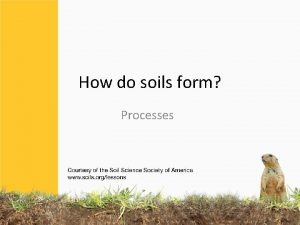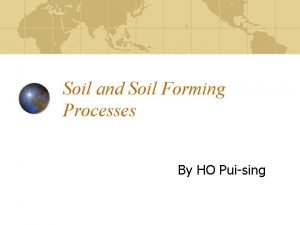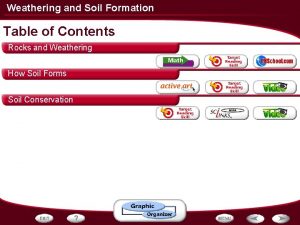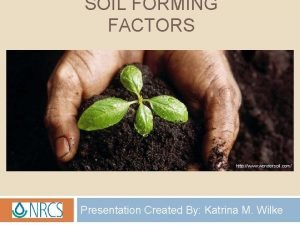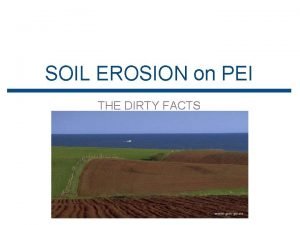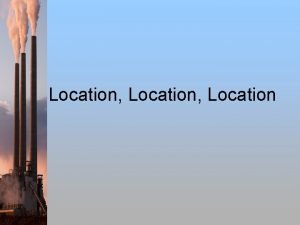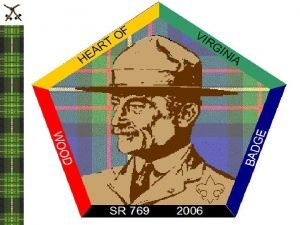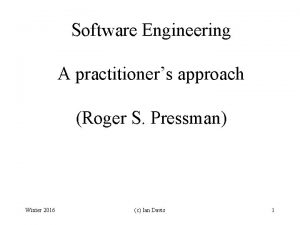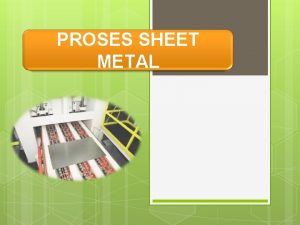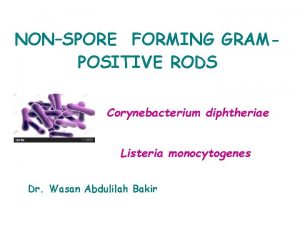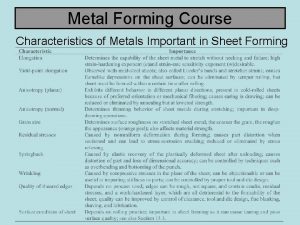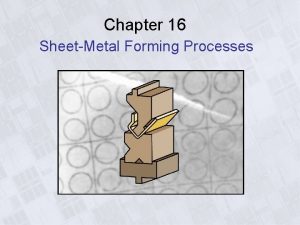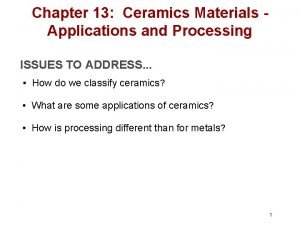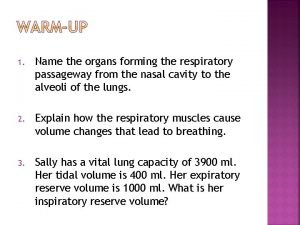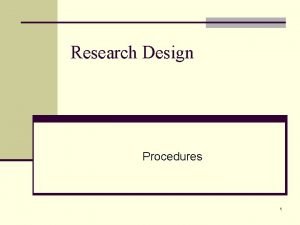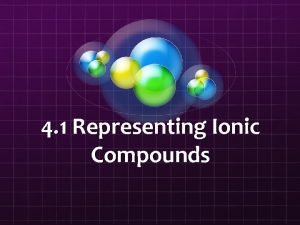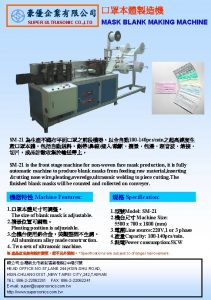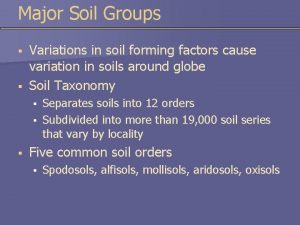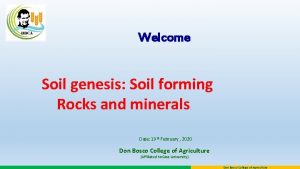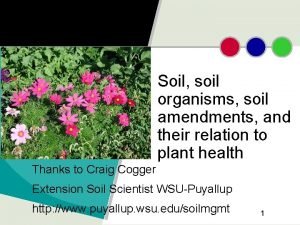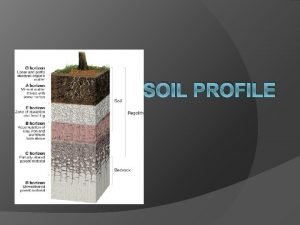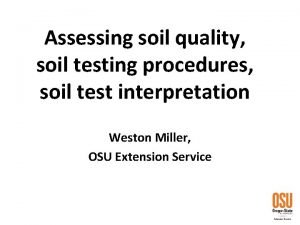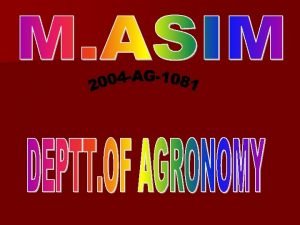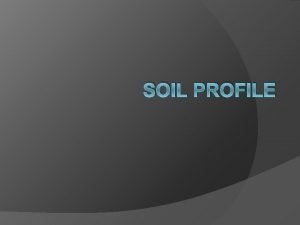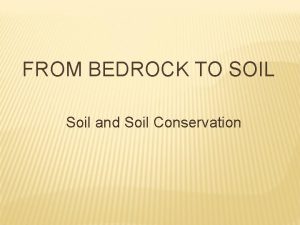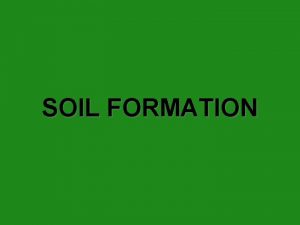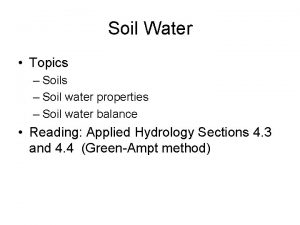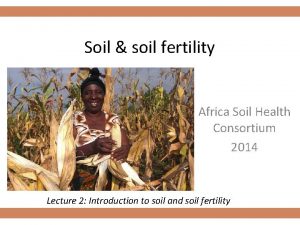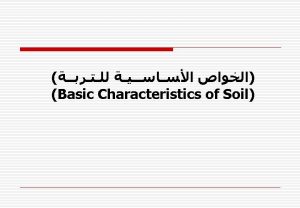SOIL FORMING FACTORS http www wondersoil com Presentation













































- Slides: 45

SOIL FORMING FACTORS http: //www. wondersoil. com/ Presentation Created By: Katrina M. Wilke

What is Soil An evolving, living layer at the Earth’s surface (pedosphere) In dynamic equilibrium with other layers Mediates most of the biological, geological, physical, and chemical interactions http: //www. nature. com/scitable/knowledge/library/the-soil-biota-84078125

Importance of Soil Provides food, minerals, fuels, fiber, and building material for humans Provides water, nutrients, and habitat for plants, microorganisms, and animals Mediates waste disposal (decomposition) and water filtration

Soil as a Natural Resource Limiting and non-renewable resource Human society is built on a terrestrial foundation http: //www. history. com/topics/dust-bowl/photos Abuse can result in the collapse of civilizations Understanding soil can result in sustaining and improving the human habitat http: //www. history. com/topics/dust-bowl/photos

Soil Composition? Minerals of different sizes Organic materials Open space � Water � Air http: //www. ctahr. hawaii. edu/mauisoil/a_comp. aspx Healthy soils have 45% mineral, 5% organic matter, 25% air, and 25% water

Mineral Particles and Soil Texture Sand: 0. 05 -2. 00 mm Silt: 0. 002 -0. 05 mm Clay: <0. 002 Soil texture is the ratio of mineral particles There are twelve soil textures http: //www. cmg. colostate. edu/gardennotes/213. html

Soil Forming Factors Parent Material Climate Organisms Relief Time http: //cals. arizona. edu/watershedsteward/resources/module/Soil/soils-intro-pg 3. htm#

Soil Forming Processes Additions � Inputs of water, nitrogen, sediments, salts, organic matter, fertilizers Losses � Leaching, erosion losses, nutrient losses, water losses, carbon as CO 2, nitrogen losses Translocations � Movement of clays, soluble salts, minerals and organic material Transformations � Mineralization of organic matter, alteration and dissolution of minerals, secondary layer silicates, and

Soil Forming Processes LOSSES ADDITIONS TRANSLOCATIONS TRANSFORMATIONS LOSSES

How are Soils Made?

Parent Material http: //www. americaswetlandresources. com/background_facts/detailedstory/Soil. Definitions. html

Parent Material: What is it? Unconsolidated material in which soil forms Grouped according to how the material is moved Loess and ash Glacial till Peat Floodplain sediments “alluvium” Glacio-fluvial deposits colluvium rock weathered in place ‘residuum’

Parent Material: Types Moved by gravity � Colluvium Moved by wind � Eolian (sands and loess) Moved by water � Alluvium http: //www. usu. edu/geomorph/images 6. html

Parent Material: Types Weathered in place � Residuum (bedrock) Moved by ice � Glacial Volcanoes � Volcanic ash http: //www. sd. nrcs. usda. gov/technical/houdeksoil. html

http: //www. sdgs. usd. edu/geologyofsd/geosd. html

Climate http: //7 billionactions. org/story/1315 -a-student-learning-about-climate-change

Climate: What is climate? Precipitation Temperature Wind Seasonal and daily changes Microclimates

Climate: What does it effect? Vegetative growth (rate and kind) Rate of biological, physical, and chemical reactions Leaching Weathering Transportation of material

Climate: Precipitation (inches)

Climate: Temperature (average max)

Climate: Soil Development Cold, dry climates � weak to modest profile development Photo taken by the Redfield SSO, Used with Permission Warm, humid climates � strong, deep profile development http: //www. grassportal. org/research. html

Organisms http: //halifaxgardennetwork. wordpress. com/tag/microbes/

Organisms: Types Vegetation � grass, trees, shrubs, and agricultural crops � native and non-native Fauna � macro: nematodes, arthropods, earthworms, insects, small vertebrates � micro: bacteria, algae, fungi, and protozoa Humans

Organisms: Vegetation Roots hold soil in place and create pore space Provide nutrients for soil microorganisms Water travels through root channels Different roots have various effect on soil Soil Formed in a Prairie http: //www. sd. nrcs. usda. gov/technical/houdeksoil. html Soil Formed in a Forest http: //en. wikipedia. org/wiki/File: Alfisol. jpg

Organisms: Native Vegetation Climate Topography Biological factors Soil factors � Soil density � Depth � Chemistry � Temperature � Moisture

Organisms: Fauna Macro � Excavate and rearrange � Contaminate Micro � Decompose � Convert organic matter materials into plant nutrients � Bio-remediation http: //www. rw. ttu. edu/2302_butler/chapter 6. htm

Organisms: Humans Increased population and agriculture Equipment and chemicals Industry and urban settlements Infrastructure and mining

Topography http: //www. cerritos. edu/esci/tutor/Groundwater/karst_topography_1_answers.

Topography: What is it? Steepness, landscape position and surface shape of a section of land http: //proceedings. esri. com/library/userconf/proc 95/to 200/p 153. html

Topography: What does it effect? Local changes in climate � Aspect effects moisture and temperature Water movement Depth, wetness, color, etc of soil profile � All other forming factors are constant Rate of water flow � Infiltration � Runoff

Topography: Landscape Positions Hill or Mountain Shoulder Backslope River Valley Terrace Footslope Tread Depression Riser Toeslope Channel & Floodplain Summit

Catena Concept: Hydrology Latin for “chain” Sequence of soils in different positions in the landscape � Erosion-Deposition � Solute transport � Differential soil hydrology

Catena Concept: Hydrology Aerobic Hydrologic flow Ground water table Weathering & Solute Leaching Anaerobic Solute Precipitation

Catena Concept: Soil Development Shoulder � Well drained, relatively deep soil Backslope � Increased surface runoff, thinner soil Footslope � more http: //soil. gsfc. nasa. gov/index. php? section=78 poorly drained, thick soil Summit � wetter than the shoulder and backslope

Time http: //www. eoearth. org/article/Soil_forming_facto rs

Time Period soil is subjected to weathering Soil formation can be a slow process Changes can occur in hundreds to millions of years Short term changes � Human activity � Natural disasters Fire, flood, volcano

Time: Soil Development

Time: Soil Development Time Parent Material Young Soil Entisol Mature Soil Mollisol Older Soil Alfisol http: //www. swac. umn. edu/classes/soil 2125/doc/s 4 chp 4. htm

Time: Young Soil In the process of adjustment to its environment. A fresh deposit of alluvium or earthy manmade fill is soil if it can support plants. Constantly subjected to erosion http: //soils. usda. gov/technical/classification/orders/entisols.

Time: Mature Soil In dynamic equilibrium with climatic and vegetative influences Not changing either physically or chemically Stable environment http: //www. sd. nrcs. usda. gov/technical/houdeksoil. html

Soil Degradation Physical, Chemical, and Anthropogenic

Degradation: Physical Erosion Compaction Water excess and deficit http: //intechweb. wordpress. com/2011/11/30 http: //www. eoearth. org/article/Soil_compactio n

Degradation: Chemical Acidification � Leaching � Microbial http: //www. fao. org/docrep/R 4082 E/r 4082 e 08. htm respiration Salinisation � Irrigation Sodification http: //www. regional. org. au/au/roc/1981/roc 198131. htm

Degradation: Anthropogenic Deforestation Improper irrigation Misuse of land Acid rain Overgrazing Construction waste Excessive use of Heavy metals fertilizers Power generation Poor land drainage emissions

Thank you for your time! USDA prohibits discrimination in all its programs and activities on the basis of race, color, national origin, age, disability, and where applicable, sex (including gender identity and expression), marital status, familial status, parental status, religion, sexual orientation, political beliefs, genetic information, reprisal, or because all or part of an individual’s income is derived from any public assistance program.
 Bài thơ mẹ đi làm từ sáng sớm
Bài thơ mẹ đi làm từ sáng sớm Cơm
Cơm 4 soil forming processes
4 soil forming processes Living soil vs dead soil
Living soil vs dead soil What are the four spheres of the earth
What are the four spheres of the earth Eluviation and illuviation
Eluviation and illuviation 5 factors of soil formation
5 factors of soil formation How soil is formed
How soil is formed Soil loss estimation
Soil loss estimation Http //mbs.meb.gov.tr/ http //www.alantercihleri.com
Http //mbs.meb.gov.tr/ http //www.alantercihleri.com Siat ung sistem informasi akademik
Siat ung sistem informasi akademik Situation vs site
Situation vs site Biotic and abiotic components of an ecosystem
Biotic and abiotic components of an ecosystem Abiotic factors and biotic factors
Abiotic factors and biotic factors Aboitic environment
Aboitic environment Biotic vs abiotic
Biotic vs abiotic Site vs. situation
Site vs. situation List the factors of 8
List the factors of 8 Factors if 7
Factors if 7 What are the factors of 8
What are the factors of 8 Diameters of fetal head
Diameters of fetal head Vertex presentation
Vertex presentation Four stages of a team
Four stages of a team Roger s pressman
Roger s pressman Sheet metal forming adalah
Sheet metal forming adalah Corynebacterium diphtheriae spore forming
Corynebacterium diphtheriae spore forming Cold working of metals
Cold working of metals Fine blanking
Fine blanking Casting forming and welding mcq
Casting forming and welding mcq Forming and solving linear equations
Forming and solving linear equations Forming and solving linear equations worksheet
Forming and solving linear equations worksheet Unit chemical bonding forming ionic compounds ws 2
Unit chemical bonding forming ionic compounds ws 2 Synthesizing information allows a reader to
Synthesizing information allows a reader to Forming process in sheet metal
Forming process in sheet metal Die blanks ceramics
Die blanks ceramics Organs forming the respiratory passageway
Organs forming the respiratory passageway Forming research design
Forming research design Bulk deformation and sheet metal forming
Bulk deformation and sheet metal forming Question in french
Question in french Vacuum forming basics
Vacuum forming basics Forming questions in spanish
Forming questions in spanish Vacuum forming tips and tricks
Vacuum forming tips and tricks Malignant neoplasm of the blood-forming organs
Malignant neoplasm of the blood-forming organs In forming ionic bonds
In forming ionic bonds Bulk deformation processes
Bulk deformation processes Ultrasonic mask blank machine
Ultrasonic mask blank machine


